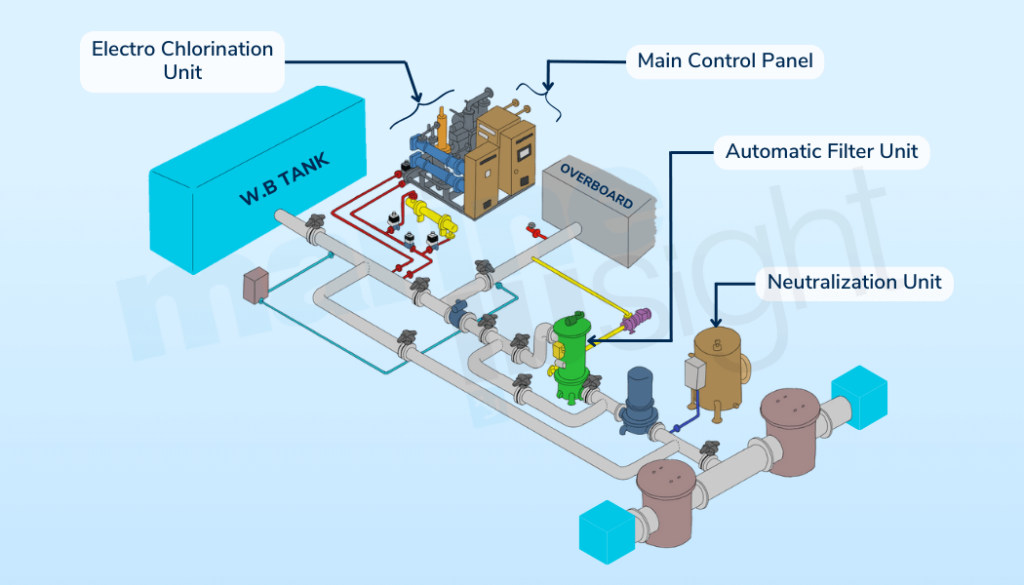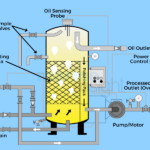10 Oily Water Separator (OWS) Maintenance Tips Every Ship Engineer Must Know
Every engineer on the ship knows the importance of oily water separator (OWS) and must have heard stories of legal actions taken against seafarers who tried to fiddle or bypass the automation system of the OWS.
The most common cause of people tampering with oily water separator is the deterioration of the performance of the system.
Apart from the filter getting clogged due to continuous usage, there can be many other reasons for the lack of performance.
A few critical points, which are often ignored and less commonly known to engineers operating oily water separator on daily basis, are discussed in this article to ensure efficient performance of oily water separator (coalesce filter type) used onboard ships:
1. Oil In Bilge: The separator is suitable for separating a small quantity of oil in the bilge and not the other way round. If there is a mixture consisting of a small quantity of water in oil, better not to pass it through the OWS and directly transfer it to waste oil tank for sludge disposal to shore or for incineration.
2. Keep Viscosity in Limit: Highly viscous oil if supplied for oily water separation will clog the filter. It is important to keep the viscosity of the oil within 1000 mm2/s
3. Discharge Outside Separator: Never discharge or drain water-oil mixture from the separator abruptly out of OWS as it will lead to the separated oil adhere to coalescers, making it inoperative. Ensure to discharge the collected separated oil outside the separator and clean the internals of the OWS by supplying water.
4. Install Dust Filter: While using OWS for discharging bilge mixture containing dust and sand (a coarse-grained entity), it will be difficult for the coalescer filter to pass dust and sand due to their sizes. This will reduce the operating hours of the filter and in-turn the efficiency of the OWS. The ideal service life of the filter normally ranges from 1-2 year depending upon the manufacturing process, considering the daily operation of one hour. It is advisable to install a dust filter in the inlet line of the OWS to avoid this trouble.
5. Exchanging Probe for Fault Finding: In most of the 15ppm OWS models, the oil level detecting probe and transmitting converter in the 1st and 2nd stage chamber are identical. In the event of trouble, exchange these with each other, between the chambers, as this will help in finding out the source of trouble quickly.
6. Keep Check On Heating Device: If a heating device is provided, ensure it is ON when OWS is in operation and switched OFF before OWS is stopped. In case when the OWS is run for a long time, keep a track on the heater for overheating of coils. If the separator is overheated to a high extent, there may be some production of inflammable gases inside.
7. Protect Internal Coating: The OWS internals are applied with tar epoxy coating, which is inflammable. Avoid bringing fire near to it or perform welding over the surface or body as the heat generated will damage the coating, making OWS susceptible to corrosion
8. Check Water Level: Ensure that the separator is initially filled with seawater before the bilge mixture is supplied to it. This is to increase the life of filters and also to maintain the operational efficiency of the separator
9. Prevent Leakage: Ensure the means provided to avoid leaking or flowing out of water due to siphon effect. Failure to do so will allow the oil to flow in the secondary chamber highly affecting the treatment capability of the machine and clogging the 2nd stage filters
10. Check Effluent: Frequent checks on effluent to be done to assess the performance of the separator. If the effluent is found contaminated, immediately stop the separator and take preventive actions
The operator of OWS should be thorough about the system, design, piping arrangement and of course the operating procedure of oily water separator. Out of all the machinery systems, OWS is kept at high priority due to stringent rules and regulations attached to it for ensuring environmental compliance. Hence it is important for the ship staff to maintain this machine in best of its shape.
Over to you..
Do you know any OWS maintenance tips that should be added to the list?
Let’s know in the comments below.
Do you have info to share with us ? Suggest a correction
Latest Marine Technology Articles You Would Like:
- 10 Oily Water Separator (OWS) Maintenance Tips Every Ship Engineer Must Know
- How to Operate an Oily Water Separator (OWS) on Ship?
- 20 Important Factors For Oily Water Separator Operation On Ships
- Oily Water Separator: Construction and Working
- What Factors Affect Separation in Oily Water Separator on Ships?
Subscribe To Our Newsletters
By subscribing, you agree to our Privacy Policy and may receive occasional deal communications; you can unsubscribe anytime.
Web Stories

About Author
An ardent sailor and a techie, Anish Wankhede has voyaged on a number of ships as a marine engineer officer. He loves multitasking, networking, and troubleshooting. He is the one behind the unique creativity and aesthetics at Marine Insight.























Normally we have two suctions for OWS, from Bilge Tank and from Bilge Wells.
Try to collect the bilge water from wells to bilge tank and run the OWS only if you need to pump out from tank.
The arrangement provide low and high level switch at bilge tank so the OWS can start automatically. We can always switch to manual operation.
The advantage of this methode is the liquid that enter to OWS is mostly water, off course you have to check the level of oil inside the bilge tank regularly.
Good
Under item4. Usually the filter life is around 4 months. If sand & gravel is used, the top layer requires a change every 3 to 4 months. Under exceptional conditions the changes for filters and sand could be at an interval of 6 months. This is because clean water also contains TDS that get caught in the filtration system. Changes above this time period is an invitation for closer scutiny by USCG, Hamburg Police etc.
Also ensure that the Oil Record Book is correctly filled& signed by the Engr incharge of the operation, followed by C/E.
Solvents and cleaners dissolved in the bilge water may cause oil and dirt to stay mixed and not seperate properly. If water is cloudy, ppm sensor will react. If possible test ph of water before attempting to process. Cleaners can be neutralised easily with a small amount of chlorine or vinegar.
Dear sir if the ows is not working/malfunction what actions to take , how to handle PSC.
@Murundadasan:
1. Immediately inform the company
2. Make an entry in the ORB about the malfunction of the OWS
3. Collect bilge in Bilge tank and record all the transfer details.
4. Show all the records to PSC and the request sent to the company about the OWS.
Is it mandatory or not to be sailing to operate OWS? If yes, which rule says it? Thanks.
Why the regulation says 15 ppm why not 20 or 30ppm, any specific reason behind this
Dear sir…
Please give me your advice …
How to do if OWS display monitor suddenly blackout. And alarm has came on Engine control room OWS concentration abnormal.
Meantime directly engineer on duty took action to check to local side check the input current To monitor in Normally…please dear all of u help me, I very highly need your feedback soon.ths
HI engineers
about the ows certaficate.
evry one year a technical person come on board to calibrate the 15 ppm sensor , and issued a new certaficate.
how will I test the oil sensing probe??